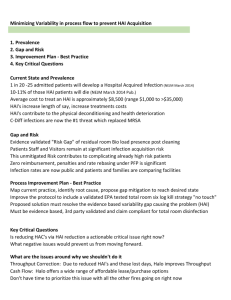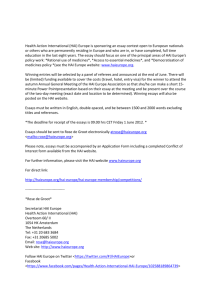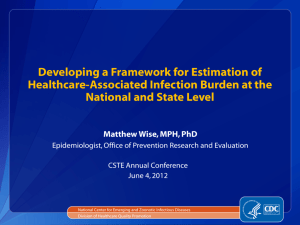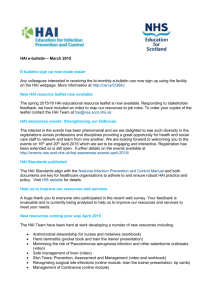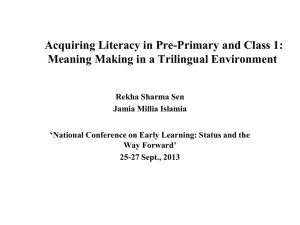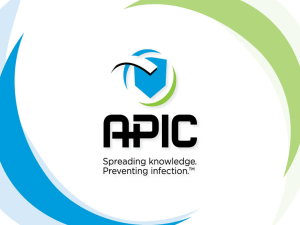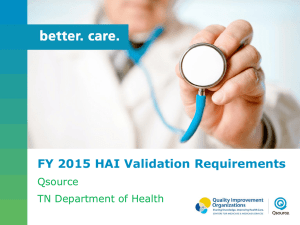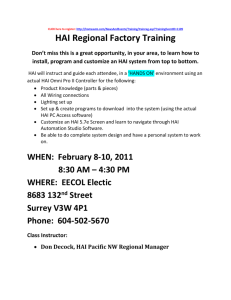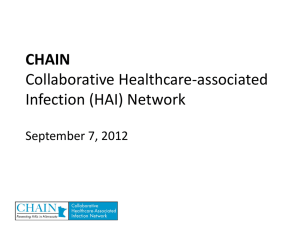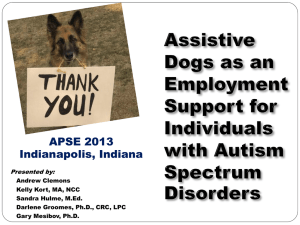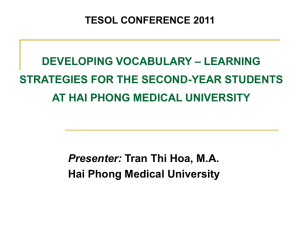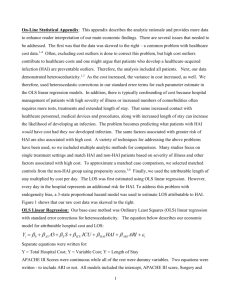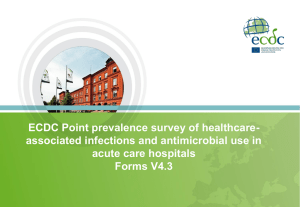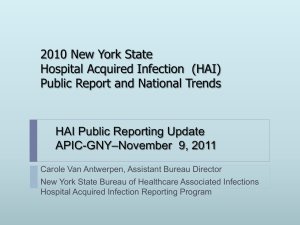Patient Safety Summit
advertisement
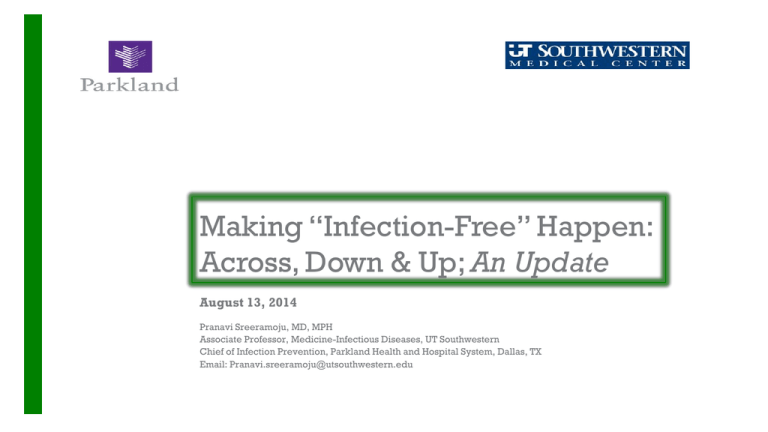
Making “Infection-Free” Happen: Across, Down & Up; An Update August 13, 2014 Pranavi Sreeramoju, MD, MPH Associate Professor, Medicine-Infectious Diseases, UT Southwestern Chief of Infection Prevention, Parkland Health and Hospital System, Dallas, TX Email: Pranavi.sreeramoju@utsouthwestern.edu + HAI Reduction at Parkland: FY09 to FY13 -60.0% -80.0% -100.0% -75.5% -90.3% -38.2% -49.0% 52.8% C.difficile associated diarrhea of Hospital Onset -40.0% VRE Hospital Onset BSI -20.0% MRSA Hospital Onset Bloodstream Infections 0.0% SSIHysterectomy 20.0% % Change in Rate in FY2013 compared to Baseline Rate in FY2008 0.0% VAP - adult ICUs 40.0% CLABSI - ICUs 60.0% + HAI Reduction at Parkland: FY09 to FY13 Rate of Known HAI through IC Surveillance CLABSI - ICUs (per 1000 catheter-days) Ventilator Associated Pneumonia - adult ICUs (per 1000 ventilator-days) SSI-Hysterectomy (% of procedures) MRSA Hospital Onset Bloodstream Infections (Infection per 10,000 patient-days) VRE Hospital Onset BSI (Infection per 10,000 patient-days) C.difficile associated diarrhea of Hospital Onset (Infection per 10,000 patient-days) FY09 FY13 %Change 5.3 1.3 -75.5% 14.4 3.4 1.4 2.1 -90.3% -38.2% 0.98 0.5 0.5 0.5 -49.0% 0.0% 3.6 5.5 52.8% + Project RITE: FY2013 to FY2016 ‘Reduce Infections Together in Everyone’ A Texas 1115 Waiver Program for Quality Transformation at Parkland Executive Sponsors: Ron Laxton, RN, PhD and Chris Madden, MD, MBA Project Lead: Pranavi Sreeramoju, MD, MPH Project Managers: Herron Mitchell, Nancy Baez, David Huffman, and Joanne Muturi + AIM Statement (1 of 2) Compared to FY2013 baseline rates at Parkland, • FY2015 and FY2016 - 20% per year reduction in Central Line Associated Bloodstream Infection (CLABSI) in ICUs, Wards, and outpatients • FY2015 and FY2016 - 20% per year reduction in Catheter Associated Urinary Tract Infection (CAUTI) in ICUs, and Wards + AIM Statement (2 of 2) Compared to FY2013 baseline rates at Parkland, • FY2015 and FY2016 - 8% per year reduction in SSI occurring after seventeen types of procedures. • Improve adherence to 3-hour and 6-hour Sepsis Management Bundle for patients admitted with Sepsis in the Emergency Department + Our Interventions 1. Reduce Variation in Processes of Care and Standardize Curriculum and Training 2. Engage Clinicians & Stakeholders 3. Have Bi-weekly Learning Sessions 4. Train At Least 500 Champions in Process Improvement Methodologies 5. Participate in Regional Collaborative + Results Thus Far vs. FY13 10.0% 5.6% 0.0% CLABSI CAUTI -10.0% Rolling 12-Month Goal by FY16 -30.0% -50.0% Sepsis Mortality -4.3% -15.4% -20.0% -12.4% -40.0% SSI -36.0% -36.0% -40.5% + Positive Deviance Trial + Project Outputs English/Spanish Flashcards - Teach Patients How to Participate in their Care Hand Hygiene Video - Teach Patients How to Perform Hand Hygiene Infection Prevention Skills Checklist: 64 items Name for the study + Outcome Data # of Patient-days of Care # of HAI (Primary Outcome) Intervention Group 6-month 9-month Baseline Intervention 9-month FollowPeriod Period Up Period 9144 14841 15095 43 48 34 Control Group 6-month 9-month 9-month Baseline Intervention Follow-Up Period Period Period 9564 14339 14652 43 41 46 Rate of HAI per 1000 Patient-days # of CLABSI # of CAUTI # of HAP # of CDI 4.70 9 11 8 15 3.23 11 7 11 19 2.25 6 7 15 6 4.50 8 10 13 12 2.86 7 8 15 11 3.14 7 10 17 12 # of HAI associated with complications occurring during same admission within 28 days (Secondary Outcome) 8 17 8 15 10 7 0.87 1.15 0.53 1.57 0.70 0.48 3 2 0 0 0 0 5 5 13 8 6 4 15 6 10 6 6 3 Rate of HAI associated with complications per 1000 patient-days # HAI associated with permanent loss of organ or organ system # HAI associated with transfet to higher level of care # HAI associated with Death + Summary of Positive Deviance Trial Intervention may have accelerated reduction of HAI Culture of Safety decline not seen in Intervention Wards Social networks revealed that the ward manager, charge nurse, ward clerk were predominantly the ‘go-to’ people for infection prevention work Staff turnover was high during study period due to organizational situation Look for the Publication + What Others can Learn from Us: 2013 Ensure that the program meets the highest of regulatory standards , e.g., TJC, CMS Perceptions matter a great deal Optimize technical solutions first Leverage intrinsic motivation Learn from the frontline employees and stakeholders if your challenges are adaptive in nature + What Others can Learn from Us: 2014 Regulatory not done yet: Mock Surveys, Corporate Integrity Agreement, Quality Review Organization Perceptions still matter a great deal Past performance will haunt (e.g., HAC reduction program due to late start with CAUTI reduction, hemodialysis-associated CLABSI) 1115 Waiver Program is a blessing Keep At It Antimicrobial Stewardship 1, 2014 Patient Safety Summit 2013
